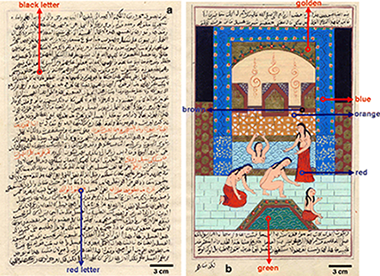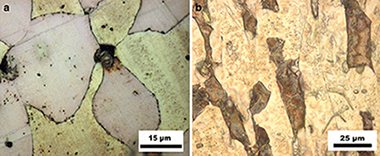Artículos SCI
2009
2009
Materiales Nanoestructurados y Microestructura
Metal carbide/amorphous C-based nanocomposite coatings for tribological applications
Sanchez-Lopez, JC; Martinez-Martinez, D; Abad, MD; Fernandez, ASurface and Coatings Technology, 204 (2009) 947-954
Show abstract ▽

This paper tries to assess the factors governing the tribological behaviour of different nanocomposites films composed by metallic carbides (MeC) mixed with amorphous carbon (a-C). Different series of MeC/a-C coatings (with Me: Ti(B) and W) were prepared by magnetron sputtering technique varying the power applied to the graphite target in order to tailor the carbon content into the films. A deep investigation of the chemical and structural features at the nano-scale is carried out by X-ray diffraction (XRD), X-ray photoelectron spectroscopy (XPS), electron energy-loss spectroscopy (EELS) and Raman spectroscopy techniques in order to establish correlations with the tribological properties measured by a pin-on-disk tribometer in ambient air. The analysis of the counterfaces by Raman confocal microscopy after the friction tests is used to follow the chemical phenomena occurring at the contact area responsible of the observed friction behaviour. The importance of determining the fraction of C atoms in the amorphous phase (xa-C) is highlighted as a key-parameter to control the tribological properties. A comparative analysis of the mechanical and tribological performance of the three systems (TiC/a-C, WC/a-C, TiBC/a-C) is done and conclusions are obtained concerning the friction and wear mechanism involved.
Diciembre, 2009 | DOI: 10.1016/j.surfcoat.2009.05.038
Characterization of illuminated manuscripts by laboratory-made portable XRD and micro-XRD systems
Duran, A; Perez-Rodriguez, JL; Espejo, T; Franquelo, ML; Castaing, J; Walter, PAnalytical and Bioanalytical Chemistry, 395 (2009) 1997-2004
Show abstract ▽

Illuminated Arabic manuscripts have been studied, employing two laboratory-made X-ray diffraction (XRD) systems developed recently in the C2RMF laboratory. The validity of the µ-XRD and XRD portable systems for the study of this type of artworks has been demonstrated. A common observation in all the analyses is the presence of calcite and rutile; also, hematite, goethite, cinnabar, brass, anatase and barite were detected in the various colours. Differences between the results obtained by both techniques due to acquisition mode are discussed. In addition, other techniques such as X-ray fluorescence (XRF) and micro-Raman were used for the complete characterization of the manuscripts.
Diciembre, 2009 | DOI: 10.1007/s00216-009-2992-5
Materiales de Diseño para la Energía y Medioambiente
Reversibility of La and Lu sorption onto smectites: Implications for the design of engineered barriers in deep geological repositories
Galunin, E; Alba, MD; Aviles, MA; Santos, MJ; Vidal, MJournal of Hazardous Materials, 172 (2009) 1198-1205
Show abstract ▽
The sorption reversibility of La and Lu (considered as actinide analogues) onto a set of smectites (bentonite FEBEX; hectorite, HEC; MX80; saponite, SAP; Otay montmorillonite, SCa-3; and Texas montmorillonite, STx-1) was studied to estimate actinide retention by smectites that are candidates for use as engineered barriers in deep geological repositories. The sorption distribution coefficients (K d) and the reversibility parameters (desorption distribution coefficients (K d,des), adjusted distribution coefficients (K d,adj), and desorption rates (R des)) were determined from batch tests in two ionic media: deionized water and Ca 0.02 mol L -1. The latter simulates possible conditions due to the presence of concrete leachates. The results varied greatly depending on the ionic medium, the lanthanide concentration and the clay structure. The high values of K d,des obtained (up to 1.1 × 10 5 and 9.2 × 10 4 L kg -1 for La and Lu in water, and 2.8 × 10 4 and 4.1 × 10 4 L kg -1 for La and Lu in the Ca medium) indicate the suitability of the tested smectites for lanthanide (and therefore, actinide) retention. Based on all the data, SCa-3, HEC and FEBEX clays are considered the best choices for water environments, whereas in Ca environments the suitable clays depended on the lanthanide considered.
Diciembre, 2009 | DOI: 10.1016/j.jhazmat.2009.07.124
Study of metallic components of historical organ pipes using synchrotron radiation X-ray microfluorescence imaging and grazing incidence X-ray diffraction
Herrera, LK; Justo, A; Munoz-Paez, A; Sans, JA; Martinez-Criado, GAnalytical and Bioanalytical Chemistry, 395 (2009) 1969-1975
Show abstract ▽

A comparative study of the composition and microstructure of two different brass alloys from reed pipes, one from a Spanish baroque organ and the other from a modern one, was carried out. This study allowed us to determine the procedure followed to produce the brass used to make ancient reed pipes. Moreover the distribution and correlation of lead and other trace elements present into the main component of the brass, the copper and zinc phases, of the historical tongues and shallots were established. This chemical composition was compared with that of a tongue from a twentieth-century organ. The whole study was accomplished using a combination of laboratory and synchrotron radiation techniques. X-ray fluorescence was the technique used to obtain elemental and chemical imaging of the main phases and the trace elements at a sub-micrometer scale.
Diciembre, 2009 | DOI: 10.1007/s00216-009-3075-3
Materiales Nanoestructurados y Microestructura
Thermogravimetric and in situ SEM characterisation of the oxidation phenomena of protective nanocomposite nitride films deposited on steel
Mege-Revil, A; Steyer, P; Thollet, G; Chiriac, R; Sigala, C; Sanchez-Lopez, JC; Esnouf, CSurface and Interface Analysis, 204 (2009) 893-901
Show abstract ▽

The lifetime of TiN coatings is often limited by its poor resistance to high temperatures. For an optimized addition of silicon, both mechanical and physico-chemical properties are enhanced, owing to the formation of a nanocomposite structure. In this study, pure Ti and TiSi (80/20) targets were arc-evaporated to produce hard, single-layered coatings. Magnetron sputtered SiNx films were also synthesized for a comparison purpose. The nanocomposite structure was determined by XRD and TEM, and its efficiency regarding the mechanical properties was confirmed by nanohardness measurements. Through thermogravimetric experiments it is shown that in isothermal and dynamic conditions, the chemical stability inherent to SiNx controls the oxidation behaviour of TiSiN. However, in thermal cycling conditions TiSiN withstand efficiently temperature variations whereas SiNx does not. The aim of this study is to understand the role of SiNx on the oxidation of the TiSiN nanocomposite film. For this purpose, an in situ approach of the oxidation phenomena is detailed, based on experiments performed in an environmental scanning electron microscope (ESEM) operating in controlled pressure mode up to 1000 °C. ESEM, used in real-time oxidative conditions, has been proved to be an efficient tool to characterise the mechanism of degradation. The successive steps of the attack throughout the in situ oxidation process are as follow: oxidation first initiates at coating defects (open pores and droplets), then spreads to the whole surface. The whole flaking of the film that is observed at the microscopic scale during the cooling step proves the poor thermal fatigue resistance of SiNx. This strong propensity to cracking is explained on the basis of thermo-mechanical considerations. The nanocomposite structure thus combines the chemical stability inherent to the SiNx matrix with the beneficial thermo-mechanical properties associated to TiN nanograins.
Diciembre, 2009 | DOI: 10.1016/j.surfcoat.2009.06.040
- ‹ anterior
- 387 of 422
- siguiente ›














